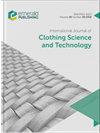A review on active heating for high performance cold-proof clothing
IF 1
4区 工程技术
Q3 MATERIALS SCIENCE, TEXTILES
International Journal of Clothing Science and Technology
Pub Date : 2023-10-05
DOI:10.1108/ijcst-03-2021-0036
引用次数: 0
Abstract
Purpose The present study provides a comprehensive review of the advancements in five active heating modes for cold-proof clothing as of 2021. It aims to evaluate the current state of research for each heating mode and identify their limitations. Further, the study provides insights into the optimization of intelligent temperature control algorithms and design considerations for intelligent cold-proof clothing. Design/methodology/approach This article presents a classification of active heating systems based on five different heating principles: electric heating system, solar heating system, phase-change material (PCM) heating system, chemical heating system and fluid/air heating system. The systems are analyzed and evaluated in terms of heating principle, research advancement, scientific challenges and application potential in the field of cold-proof clothing. Findings The rational utilization of active heating modes enhances the thermal efficiency of cold-proof clothing, resulting in enhanced cold-resistance and reduced volume and weight. Despite progress in the development of the five prevalent heating modes, particularly with regard to the improvement and advancement of heating materials, the current integration of heating systems with cold-proof clothing is limited to the torso and limbs, lacking consideration of the thermal physiological requirements of the human body. Additionally, the heating modes of each system tend to be uniform and lack differentiation to meet the varying cold protection needs of various body parts. Research limitations/implications The effective application of multiple heating modes helps the human body to maintain a constant body temperature and thermal equilibrium in a cold environment. The research of heating mode is the basis for realizing the temperature control of cold-proof clothing and provides an effective guarantee for the future development of the intelligent algorithms for temperature control of non-uniform heating of body segments. Practical implications The integration of multiple heating modes ensures the maintenance of a constant body temperature and thermal balance for the wearer in cold environments. The research of heating modes forms the foundation for the temperature regulation of cold-proof clothing and lays the groundwork for the development of intelligent algorithms for non-uniform heating control of different body segments. Originality/value The present article systematically reviews five active heating modes suitable for use in cold-proof clothing and offers guidance for the selection of heating systems in future smart cold-proof clothing. Furthermore, the findings of this research provide a basis for future research on non-uniform heating modes that are aligned with the thermal physiological needs of the human body, thus contributing to the development of cold-proof clothing that is better suited to meet the thermal needs of the human body.高性能防寒服装的主动加热研究进展
本研究全面回顾了截至2021年防寒服装的五种主动加热模式的进展。它旨在评估每种加热模式的研究现状,并确定其局限性。此外,该研究还为智能温度控制算法的优化和智能防寒服装的设计考虑提供了见解。本文根据五种不同的加热原理对主动加热系统进行了分类:电加热系统、太阳能加热系统、相变材料(PCM)加热系统、化学加热系统和流体/空气加热系统。对这些系统的加热原理、研究进展、科学挑战和在防寒服装领域的应用潜力进行了分析和评价。结果合理利用主动加热方式,可以提高防寒服的热效率,增强防寒服的耐寒性,减小防寒服的体积和重量。尽管五种流行的加热方式在发展方面取得了进展,特别是在加热材料的改进和进步方面,但目前将加热系统与防寒服装的结合仅限于躯干和四肢,缺乏对人体热生理需求的考虑。此外,各系统的加热方式趋于统一,缺乏差异性,无法满足人体各部位不同的防寒需求。研究局限/启示多种加热方式的有效应用有助于人体在寒冷环境中保持恒定的体温和热平衡。加热方式的研究是实现防寒服装温度控制的基础,为今后身体部位不均匀加热温度控制智能算法的发展提供了有效保障。多种加热模式的集成确保了在寒冷环境中穿戴者保持恒定的体温和热平衡。加热方式的研究为防寒服装的温度调节奠定了基础,为不同身体部位的非均匀加热控制智能算法的发展奠定了基础。本文系统综述了适用于防寒服装的五种主动加热方式,为未来智能防寒服装的加热系统选择提供指导。此外,本研究结果为今后研究符合人体热生理需求的非均匀加热方式奠定了基础,有助于开发更适合人体热需求的防寒服装。
本文章由计算机程序翻译,如有差异,请以英文原文为准。
求助全文
约1分钟内获得全文
求助全文
来源期刊
CiteScore
2.40
自引率
8.30%
发文量
51
审稿时长
10 months
期刊介绍:
Addresses all aspects of the science and technology of clothing-objective measurement techniques, control of fibre and fabric, CAD systems, product testing, sewing, weaving and knitting, inspection systems, drape and finishing, etc. Academic and industrial research findings are published after a stringent review has taken place.

 求助内容:
求助内容: 应助结果提醒方式:
应助结果提醒方式:


